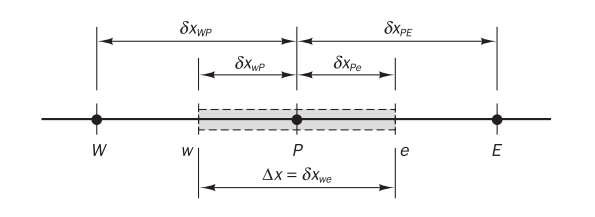CFD-FVM-06: The Finite Volume Method for Diffusion Problems

Introduction
The governing equation of steady diffusion
The control volume integration
Finite volume method for one-dimensional steady state diffusion
The process is governed by

Step 1: Grid generation
The usual notations are shown as follows

Step 2: Discretisation
For the control volume defined above the integration is
Here
For a uniform grid, the simplest way to get the value at the interface is the central differencing:
Then
The source term is approximated by a linear interpolation
Finally we have
Rearrange the equation
We assign
Then
Step 3: Solution of equations
Above discretised equations must be set up at each of the nodal points in order to solve a linear algebraic equations to obtain the solution.
Worked examples: onedimensional steady state diffusion
The equation governing one-dimensional steady state conductive heat transfer is
The source term can, for example, be heat generation due to an electrical current passing through the rod.
Example 1
No source term:


For node 2, 3 and 4,
Integration of the equation over the control volume surrounding point 1 gives
Rearrange the equation yields
The similar manner can be applied to point 5 with
All the coefficients and equations can form a matrix equation which can be solved by a linear algebraic solver. Then we can obtain the temperature distribution.
Example 2
A uniform heat generation of q:
Assuming that the dimensions in the


For node 2, 3 and 4 we have
Rearrange the equation to the form of
For node 1 we have
Rearrange the equation to the form of
For node 5 we have
Rearrange the equation to the form of
Example 3
We consider a cylindrical fin with uniform crosssectional area
where


Since
Integration of the above equation over a control volume gives
The second integral due to the source term in the equation is evaluated by assuming that the integrand is locally constant within each control volume:
For node 2, 3 and 4 we have
Rearrange the equation to the form of
For node 1 we have
Rearrange the equation to the form of
For node 5 we have
Rearrange the equation to the form of
Finite volume method for two-dimensional diffusion problems
Consider a two-dimensional steady diffusion problem
When the above equation is formally integrated over the control volume we obtain
Given the grid as

we have
Using the central difference we have
This yields the form of
Finite volume method for three-dimensional diffusion problems
Steady state diffusion in a three-dimensional situation is governed by
Given the grid as

we have
Discretizing the above equation using the central difference we have
This yields the form of
Summary
- The discretised equations have a general form:
wheremeans the neighbouring nodes. - In all cases the coefficients around point P satisfy the following relation:
with the values in below table
| 1D | 0 | 0 | 0 | 0 | ||
| 2D | 0 | 0 | ||||
| 3D |
- Source terms can be included by identifying their linearised form
and specifying values for and . - Boundary conditions are incorporated by suppressing the link to the boundary side and introducing the boundary side flux – exact or linearly approximated – through additional source terms
and . For a one-dimensional control volume of width with a boundary B: - link cutting: set coefficient
- source contributions:
- fixed value
:
- fixed flux
:
- fixed value
- link cutting: set coefficient